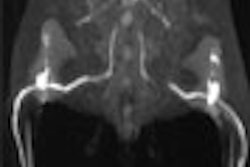
AuntMinnie.com is pleased to present Part V of our series, Turf Wars in Radiology.
The bad news, at least from the radiologist's perspective, is that many orthopedists like to perform their own imaging studies. The good news is that some radiologists are beginning to deliver musculoskeletal imaging services in ways that make it easy for their orthopedic colleagues to value and rely on radiologists' expertise.
Several radiologists offered their opinions on ways that relationships between the two specialties can be made to work. They expressed hope that their fellow radiologists can adopt strategies that promote collaboration.
Too busy for turf wars
"In our practice, the relationship between orthopedists and radiologists is very collaborative and close. I think the high level of collaboration is due to the fact that we’re both busy," said Dr. Clyde Helms. "Our colleagues in orthopedics have their hands full and don’t need to dip in and do radiology. Our radiology department holds a conference every day with one of the departments that use our services. We’re there when they have questions, so that the clinicians are not left to interpret the images on their own. As a result, they’ve come to rely on us."
Helms is a professor of radiology at Duke University in Durham, NC. In a recent article in Radiology, he cited sports medicine in particular as an area in which the future is bright for radiologists.
"Radiologists will continue to see increased requests for MR imaging, because sports medicine and high-quality imaging are inextricably linked," he stated (Radiology, September 2002, Vol. 224:3, pp. 613-635).
Helms advocates regular conferences with referring physicians to head off potential problems.
"For example, when we started the foot and ankle conference, the orthopedists were impressed with our interpretations, and the things we could see on an MRI that were valuable to them," he said. "The conferences have allowed the radiologists to tailor the interpretations to each specialty group’s needs, so that the treating physicians can make maximum use of the imaging studies that they ordered."
As in most relationships, communication is the key. "Find out what orthopedists need. That makes a huge difference," Helms said. "Ask what they want you to call abnormalities. For example, is (it) more helpful if you call it a herniation or a protrusion?"
But even in an environment as harmonious as Duke's, conflicts are inevitable. When they arise, Helms believes the radiologist should "step back from the conflict and try to understand the orthopedist’s point of view." If conflicts are resolved at an earlier stage, orthopedists are less likely to throw up their hands and get their own MRI equipment, he said.
The onsite radiologist
Physical proximity also helps ward off the anonymity that can breed frustration, said Dr. Douglas Beall, a U.S. Air Force major at Lackland Air Force Base in San Antonio, TX. He is also chief of musculoskeletal radiology at Wilford Hall Medical Center in San Antonio, and assistant professor of radiology at the Uniformed Services University of the Health Sciences in Bethesda, MD.
"My workday occurs in the orthopedics department," he said. "That’s where my reading station is, and it’s where I do some of the procedures. In such an environment, the more the orthopedists see the radiologists, the more comfortable they are, the more they want to turn over the imaging and some of the interventional procedures."
Fighting over who gets to do the imaging is unproductive, according to Beall. "There is plenty of expertise to be had on both sides of the equation in orthopedic repair and musculoskeletal imaging," Beall said. "We spend time bickering over small things ... at the expense of the people we try to take care of. If I’m interpreting orthopedic studies in a vacuum, it doesn’t help the patient or me. The same holds for the orthopedist trying to treat in a vacuum." Conversely, with a collaborative strategy, "added value is an absolute certainty. Seeing what we can add to the patient’s benefit is gratifying," he said.
Dr. Julia Crim agrees that using the terminology useful to orthopedists is good preventive medicine.
"One of the reasons I went into musculoskeletal radiology is that I love working with orthopedic surgeons," said Crim, who is chief of musculoskeletal radiology at the University of Utah in Salt Lake City. "As long as I can speak their language and give the answers they need, we have an extremely good relationship. I’ve had no significant problem in the 16 years I’ve been a radiologist."
Treating MRI like x-ray
But one area that does concern her and others in the musculoskeletal imaging community is the growing trend among orthopedists to approach MR imaging with the same nonchalance they have traditionally given the x-ray.
"The orthopedists in our group read their own garden-variety x-rays, and I help with the challenges. What some orthopedists have wanted to do is to transfer this approach to MRIs," Crim said, adding that the approach rarely works.
"An MRI is a more complex exam to perform," she said. "How we tailor the exam to the patient is an important aspect of the diagnostic information we obtain. I’ve seen centers where they do the MRI and send it to the radiologist. In that setting, we’re not serving the patient well. The radiologist isn’t performing the quality assurance on the magnet, or optimizing the sequences, or monitoring the patient. The best way to run the scanner involves close interaction between the radiologist and the technician."
She also expressed concern about self-referral, despite the existence of the Stark laws, which ban physician referral of Medicare patients to laboratories and other auxiliary services in which the physician has an investment interest.
"It’s hard for the orthopedist to turn down the money they can make. I can understand wanting to tap into that, but I don’t think it results in the best images or the best interpretations," she said.
Crim believes that radiologists must take the initiative in preventing conflicts with orthopedists. "It behooves us to be very knowledgeable in regard to the orthopedic problems we’re called on to image," she said. "We have to have a level of expertise in diagnosis that makes us someone the orthopedists are eager to consult. I read the orthopedist journals before I read the radiology journals, so I can anticipate the orthopedists’ needs. I want them to fully consult with me. Sometimes an MRI is not appropriate; perhaps a CT scan or fluoroscopy would be more useful. We need to offer our cognitive skills, not just our imaging equipment."
Duplication of services?
Radiologists and orthopedists can work well together, but the radiologist may have a more effective role in musculoskeletal imaging as a resource for complicated cases, said Dr. John Kelley IV, associate professor and vice chair of orthopedic surgery and sports medicine at Temple University Hospital in Philadelphia. He specializes in shoulder and knee surgery.
"The only concern I have is the extent to which there’s a duplication of services between radiologists and orthopedists," he said. "We’re trying to keep costs down. As orthopedists, we like to look at our own studies, both MRIs and x-rays. We have the benefit of seeing the patient along with the image."
Due to the constant exposure orthopedists get to patients’ MRIs, they have the expertise necessary to read them, he said. "If you’re seeing 100 patients a week and you’re looking at 60 imaging studies a week, you get to be pretty expert," he said.
Kelley consults with radiologists for studies he doesn't use often. "I would rely heavily on the radiologist’s interpretation of an MRI of the spine, as well as for bone scans," he said. "However, for knee MRIs and shoulder MRIs, which I see regularly, I’m much less dependent on the radiologist. The proper role is that of a resource, not that of a compulsory associate, the role they’re often cast into."
Kelley also sees medicolegal hazards in the way radiology reports are often written, with the qualification "cannot exclude," and the listing of several possible but not probable diagnoses. When the referring physician sees this in the radiology report, he or she typically feels obligated to screen for the tumors or infections that could not be excluded, for fear that a failure to follow through could lead to a subsequent lawsuit on the grounds of failure to diagnose.
Radiologists can work with referring physicians to take the sting out of that troublesome term, according to Crim.
"‘Cannot exclude’ is truly a tricky phrase, and I try to avoid it," she said. But sometimes MRI is requested to solve a problem it cannot solve definitively. For example, MRI might be ordered to evaluate for osteomyelitis in a patient who has had a recent amputation. In such a case, the normal postoperative changes in the bone marrow can mimic osteomyelitis.
"I would be forced to say in my report that I cannot exclude osteomyelitis, and a follow-up scan is recommended," she said. Still, good communication can often keep the problem from morphing into a cascade of defensive medicine.
"The best way to avoid such situations is for the radiologist to work closely with the referring doctors," Crim advised. "I encourage my clinical colleagues to call me on difficult cases before any testing is ordered, and we discuss what test is best for their purposes."
By Paula MoyerAuntMinnie.com contributing writer
October 1, 2002
Related Reading
Turf Wars in Radiology IV: Radiologists, ob/gyns sound off on fetal imaging, September 26, 2002
Multidisciplinary boards might calm radiology's raucous turf battles, August 1, 2002
Will sports imaging score as a specialty?, February 25, 2002
Turf Wars in Radiology, Part III: All is not lost in nuclear cardiology, August 31, 2001
Turf Wars in Radiology, Part I: Rads, attendings duke it out in the ER, August 10, 2001
Copyright © 2002 AuntMinnie.com



















